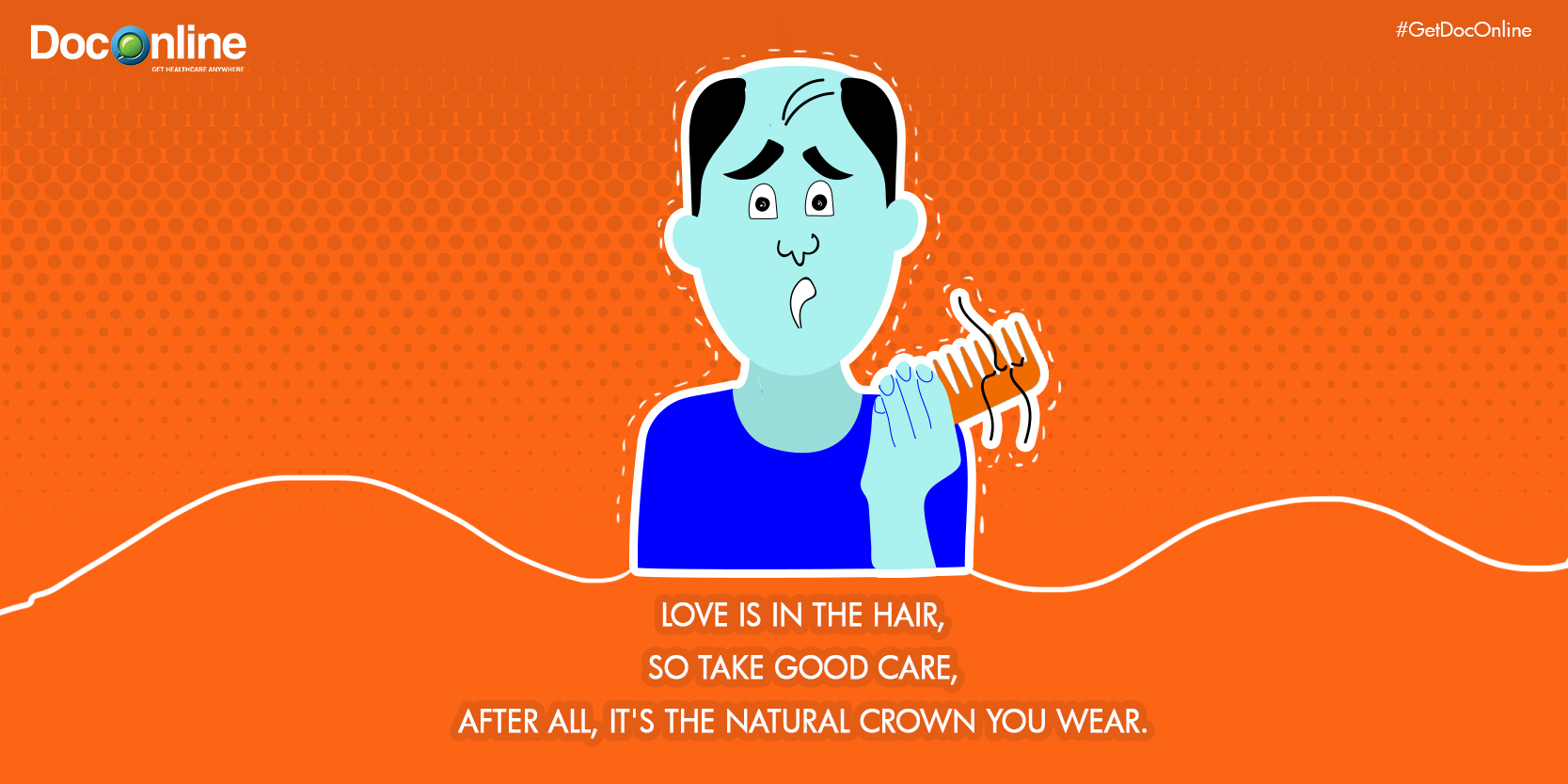Hair loss is one of the most common health problems faced by both men and women and it affects one-third of the global population. It is learned that it is natural for everyone to lose about 100 strands of hair every day. So, one shouldn’t really fret.
However, with increasing stress, pollution and nutrient-deficient diets on the rise, every 1 in 3 people face the issue of hair loss. Worrying leads to more hair fall. Hence, if you really want to prevent hair loss, it is very important to understand what causes hair fall. But before learning the causes, it is even more important to understand the hair growth cycle that helps to recognize and address many hair issues. The hair growth cycle consists of three distinct stages – anagen, catagen and telogen phases.
ANAGEN PHASE
Your hair grows about half an inch in a month and faster during summer than in winter. The growth phase or anagen phase lasts an average of 3-5 years. So, a full-length hair averages 18 to 30 inches. The anagen phase can last as much as 7 years with hair being able to grow to 1 meter.
CATAGEN PHASE
At the end of the anagen phase, your hair enters the catagen phase. It is a short transitional phase that lasts approximately 10 days.
TELOGEN PHASE
Lastly, your hair enters the telogen phase, a resting phase when your hair is released and falls out. The follicle then remains inactive for 3 months and the whole process is repeated. Each hair follicle is independent and goes through the growth cycle at different times; otherwise all your hair would fall out at once! Instead, you only shed a certain number of hairs in a day – up to 80 hairs on a healthy head of hair.
Hair loss, hair thinning and problems with hair growth occur when your growth cycle is disrupted. This can be triggered by conditions such as metabolic imbalances, illness or improper nutrition.
For instance, 6 weeks after restrictive dieting or a high fever you can experience telogen effluvium (diffused hair fall). This occurs when your anagen phase is cut short and many hairs enter the telogen phase all at the same time. If your hair growth cycle is constantly challenged, or not supported, you may find that your hair won’t grow as long as it used to. This is because your hairs are never allowed to stay in the anagen (growing) phase long enough to reach the desired length.
What are Hair Loss Causes?
Some of the usual reasons for hair fall are:
1.Dandruff – This is a condition of the scalp, which leads to the buildup of dead skin cells. This is primarily due to cohesion of corneocytes, which detach as such from the surface of stratum corneum. A lot of such similar aspects like genetic and environmental factors decide the intensity of dandruff.
How to Treat Dandruff?
Having a proper diet rich in antioxidants and vitamins helps. Almonds, walnuts, tomatoes, eggs and green leafy vegetables should be included in the diet. Do not oil your hair if you suffer from dandruff as the oil attracts dust and just leads to more build-up of dandruff.
Wash your hair every alternate day or every 2 days with anti-dandruff shampoos that have ketoconazole/salicylic acid/Piroctone olamine. Try not to touch your hair too much as it makes it greasier and invites more dandruff. Use minimum hair products like gels/setting sprays.
2. Hair fall can also occur due to some underlying medical conditions:
Medical conditions like anemia and thyroid disorders can lead to excessive hair fall. Don’t forget to consult a doctor if your hair fall is consistent and does not respond to regular home care treatment.
Alopecia: It is a medical condition where there is hair loss from the scalp or sometimes the entire body. There are various forms under this:
* Alopecia areata - autoimmune disease, also called spot baldness, where the hair loss occurs as bald patches. The alopecia areata most often affects the scalp and beard but may also occur on any part of the body with hair.
*Androgenic alopecia – This is a common form of hair loss in both men and women. In men, this condition is also known as male-pattern baldness. Hair is lost in a well-defined pattern, beginning above both temples. Over time, the hairline recedes to form a characteristic "M" shape. Hair also thins at the crown often progressing to partial or complete baldness.
The pattern of hair loss in men and women vary. Hair loss in women shows the hair becoming thinner all over the head, and the hairline does not recede. Androgenetic alopecia in women rarely leads to total baldness.
*Postpartum alopecia - Postpartum Alopecia occurs in women two to four months after giving birth and is caused by more hairs than usual remaining in the growth phase. The body experiences soaring estrogen and progesterone levels during pregnancy, which wane off during postpartum. Hence, retained hair sheds. It is usually temporary, and hair is normal within 6-8 months.
*Alopecia Totalis /Universalis: Totalis is a condition where there is a complete loss of hair from the scalp and face. Universalis is a complete loss of hair on the body. Both are autoimmune conditions. Treatment for alopecia is usually Topical Minoxidil, Glucocorticoid based therapies, and Sensitization Therapy.
2.Grey hair : The second - most common hair problem faced by new-age millennials is premature greying of hair. Hair goes grey with chronological aging. Premature hair greying may have significant adverse effects on the appearance, self-esteem and socio-cultural acceptance of the affected individual. The exact aetiopathogenetic mechanism causing premature greying is still not clear and much speculative. Premature grey hair may appear alone as an autosomal dominant trait or it may occur in association with certain other disorders. The genes Pax3 and MITE play an important role in melanocyte stem cell maintenance and differentiation. This means defective melanosomal transfer to the cortical keratinocytes or melanin incontinence due to melanocyte degeneration which leads to greying. It can also be seen in B12 deficiency along with other conditions like thyroid disorders.
What is the Treatment for Hair Greying?
- - Taking B12 supplements has shown to be of some help.
- - Embrace your greys and let it grow naturally instead of applying artificial colors, which will only increase the damage already done.
- - Having a balanced diet with loads of veggies/fruits/nuts and legumes.
- - Regularly exercise
- - Maintain a proper work-life balance
- - Quit Smoking
- - Sleep for a minimum of 7-8 hours daily.
3. Hair lice/Pediculosis: Lice are tiny insects that feed on blood from the human scalp. An infestation of head lice called pediculosis capitis often affects children and usually results from the direct transfer of lice from the hair of one person to that of another. Itching is the most common symptom of such an infestation.
Treatment:
Over-the-counter and prescription medications containing dimethicone/Permethrin are available to treat head lice. Following treatment instructions carefully is important for ridding your scalp and hair of lice and their eggs.
4.Frizzy hair: This happens when the moisture levels in the hair shafts drop. This can occur due to the weather changes or over usage of harsh shampoos and hair colors. Treatment involves conditioning your hair well and using mild hydrating shampoos instead of harsh ones. Also check if your shampoos contain harmful products like sodium Laureth sulfate/parabens and fragrance, which end up damaging your hair.
Healthy hair involves eating a lot of protein and iron-rich food like peanuts, legumes, eggs, fish and meat. Having your daily intake of biotin/Vitamin E also protects your mane. Exercising regularly also helps in redistribution of blood flow and helps hair growth. Afterall life cannot be perfect but your hair can be!
FAQ
A balanced diet, good sleep, correction of an underlying medical condition under doctor’s supervision.
A balanced diet rich in antioxidants and vitamins, good sleep, regular exercise, wash, and condition hair regularly.
Avoid hairstyles that pull hair very tight or too many treatments such as coloring, perming, etc, add vitamins and minerals to the diet, manage stress and prevent/ treat dandruff.













